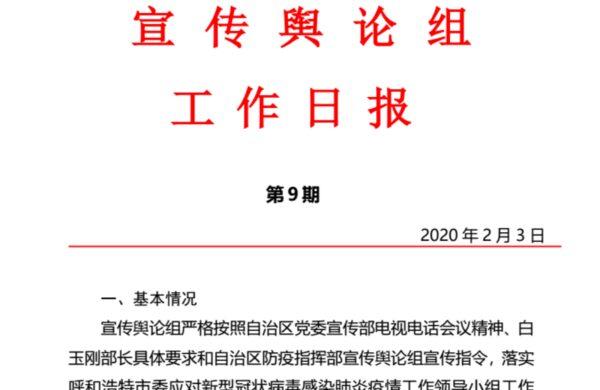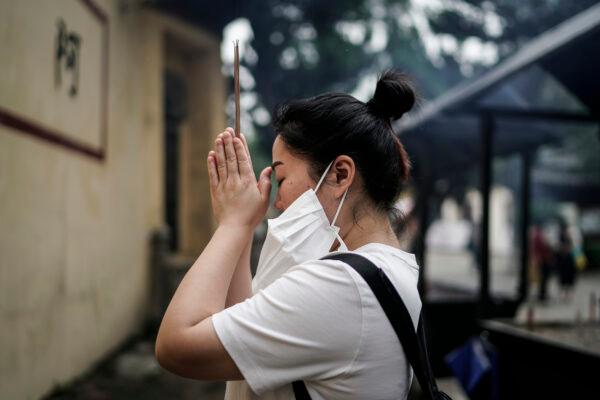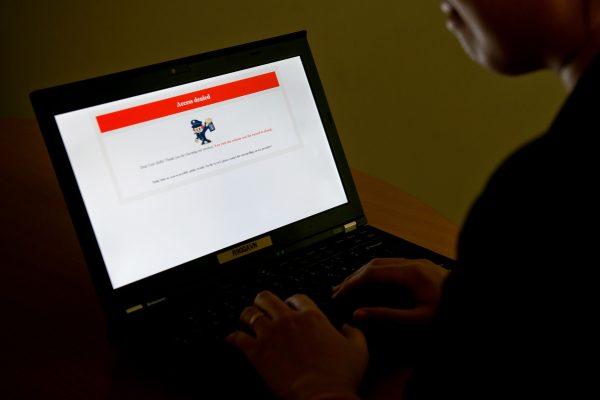Now, government documents obtained by The Epoch Times have revealed in greater detail how authorities also worked to suppress online information that didn’t align with their narrative about the pandemic, and punished those who posted such content on social media.
Authorities also set up teams of officials and state media reporters to publish articles praising the Chinese regime’s pandemic response and promote those posts online.
They also have maintained a list of news topics that the media aren’t allowed to report on, constantly updated to reflect news that’s deemed too sensitive.

Propaganda Teams
The documents come from the Inner Mongolia Chinese Communist Party committee.In one notice dated Jan. 26, the committee ordered local governments at all levels—regional, municipal, county, township, and village—to set up dedicated “propaganda teams” related to the CCP virus epidemic.
“At present, the novel coronavirus-related propaganda is our most important job. ... We need to motivate everyone [in Inner Mongolia region] and arrange tasks that can cover all aspects, to strengthen the guidance and control on epidemic-related information and speech,” the notice reads.
The regional team would be led by the propaganda minister of Inner Mongolia, with top officials spanning a range of government agencies as members, including the Cyberspace Affairs Office, Foreign Affairs Office, education department, health commission, transportation department, customs bureau, and state media outlets.
The city or county government teams would similarly be led by the local propaganda director, along with other officials in charge of health, cyberspace, media, and other areas.
The Party committee would also create “reporting teams” at the provincial, city, and county levels. State media reporters must be “politically correct and steady” in their coverage of the pandemic, the notice instructs. The leader of each team would be the chief editor of local state-run outlets.
Both the propaganda and reporting teams would be on standby 24/7, while members who aren’t on shift must be prepared to answer their phones at any time, “to prepare for emergencies,” according to the documents.

Main Tasks
The propaganda teams need to post information that aligns with the central government’s tone—on conventional media and social media platforms. The posts can be in different forms, such as news reports, commentaries, and talk shows, according to the documents.The posts would serve the purpose of “educating the people,” documents noted.
Posts should feature the “main melody” or “positive energy” about the pandemic, such as stories about restaurant owners delivering free meals to medical staff who treated COVID-19 patients; new infections are rumors; grocery stores have plenty of supplies, and so on.
The Hohhot city propaganda team wrote in its work summary on Jan. 30 that it had posted 698 CCP virus-related posts from 9 a.m. on Jan. 29 to 9 a.m. the following day.
In that 24-hour period, state-run newspaper Hohhot Daily published 18 news reports in its newspaper and 84 articles via its social media accounts, while Hohhot’s radio and television reported 40 news articles and 93 posts on its websites and social media platforms. HohhotNews.net published 79 articles on its websites and 73 posts on social media platforms.
The summary also noted that Hohhot censors promoted posts by the official government’s accounts on Weibo and WeChat, two of China’s most popular platforms. The local cyberspace office also arranged for 6,686 “volunteers” to share the government posts on social media.
The propaganda teams are also tasked with monitoring all posts and comments published on social media platforms by local residents—and punishing those responsible for content that’s not in line with the official narrative.
For example, the same work summary stated that the cyberspace office filtered out 34,218 posts in those 24 hours. Fourteen of them were identified as “important public opinion”—a euphemism for posts not approved by authorities.
“We have asked the health commission and police bureau to deal with the posts,” the summary stated. The notice didn’t explicitly explain what that meant, but in Chinese government messages, it typically connotes a form of punishment.
“The harmful posts were removed by the cyberspace office,” it added.
The propaganda office in the Alxa League government also stated in a document that it removed social media accounts and punished owners of accounts who posted unapproved information.
For example, the office stated that on March 6, it identified an account on WeChat, “Xiaotuofeng Net,” that had posted information about the local outbreak. Officials ordered the account owner to stop.

Sensitive Topics
Meanwhile, an order issued by the Hohhot government on Sept. 8 instructed all township, neighborhood, and village authorities to utilize social media to convince people to support a new education policy.Since late August, ethnic Mongolians in Inner Mongolia have protested in front of local government offices or staged school walkouts to oppose a new policy requiring classes in primary and middle schools to be taught in Mandarin Chinese and use standardized Chinese-language textbooks.
Ethnic Mongolians have a distinct language and culture from the Han Chinese ethnic majority who speak Mandarin.
Several government-operated social media accounts also publicly threatened residents that they would be “held liable” if they opposed the new policy.
Another document, more than 20,000 words long, detailed all the news topics that authorities banned from Jan. 2 to March 10.





